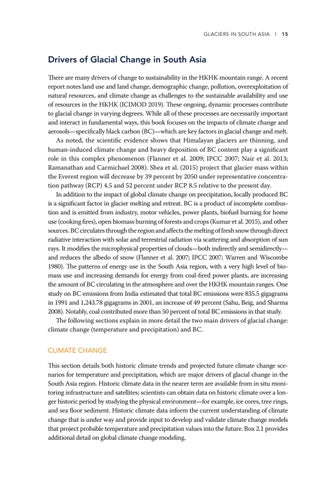Glaciers in South Asia l 15
Drivers of Glacial Change in South Asia There are many drivers of change to sustainability in the HKHK mountain range. A recent report notes land use and land change, demographic change, pollution, overexploitation of natural resources, and climate change as challenges to the sustainable availability and use of resources in the HKHK (ICIMOD 2019). These ongoing, dynamic processes contribute to glacial change in varying degrees. While all of these processes are necessarily important and interact in fundamental ways, this book focuses on the impacts of climate change and aerosols—specifically black carbon (BC)—which are key factors in glacial change and melt. As noted, the scientific evidence shows that Himalayan glaciers are thinning, and human-induced climate change and heavy deposition of BC content play a significant role in this complex phenomenon (Flanner et al. 2009; IPCC 2007; Nair et al. 2013; Ramanathan and Carmichael 2008). Shea et al. (2015) project that glacier mass within the Everest region will decrease by 39 percent by 2050 under representative concentration pathway (RCP) 4.5 and 52 percent under RCP 8.5 relative to the present day. In addition to the impact of global climate change on precipitation, locally produced BC is a significant factor in glacier melting and retreat. BC is a product of incomplete combustion and is emitted from industry, motor vehicles, power plants, biofuel burning for home use (cooking fires), open biomass burning of forests and crops (Kumar et al. 2015), and other sources. BC circulates through the region and affects the melting of fresh snow through direct radiative interaction with solar and terrestrial radiation via scattering and absorption of sun rays. It modifies the microphysical properties of clouds—both indirectly and semidirectly— and reduces the albedo of snow (Flanner et al. 2007; IPCC 2007; Warren and Wiscombe 1980). The patterns of energy use in the South Asia region, with a very high level of biomass use and increasing demands for energy from coal-fired power plants, are increasing the amount of BC circulating in the atmosphere and over the HKHK mountain ranges. One study on BC emissions from India estimated that total BC emissions were 835.5 gigagrams in 1991 and 1,243.78 gigagrams in 2001, an increase of 49 percent (Sahu, Beig, and Sharma 2008). Notably, coal contributed more than 50 percent of total BC emissions in that study. The following sections explain in more detail the two main drivers of glacial change: climate change (temperature and precipitation) and BC. CLIMATE CHANGE This section details both historic climate trends and projected future climate change scenarios for temperature and precipitation, which are major drivers of glacial change in the South Asia region. Historic climate data in the nearer term are available from in situ monitoring infrastructure and satellites; scientists can obtain data on historic climate over a longer historic period by studying the physical environment—for example, ice cores, tree rings, and sea floor sediment. Historic climate data inform the c urrent understanding of climate change that is under way and provide input to develop and validate climate change models that project probable temperature and precipitation values into the future. Box 2.1 provides additional detail on global climate change modeling.




